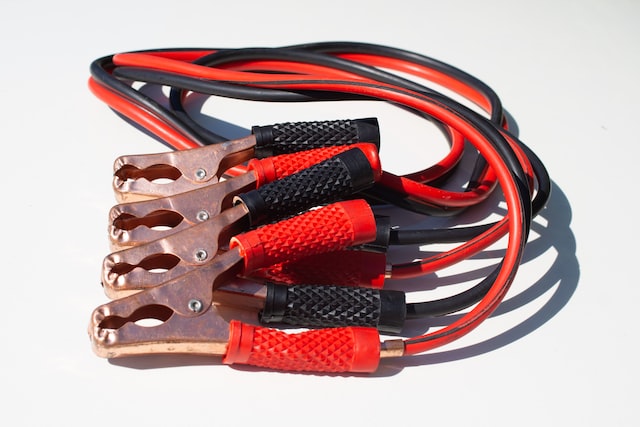Jump start your car. This article contains detailed advice on restarting your automobile and getting back on the road. This tutorial will explain each step, from connecting the jumper wires to ensuring your safety so that you may return to the road swiftly and safely.
If your vehicle’s battery is dead, you may restart it using a set of cable connections and a second vehicle with a functioning battery. Ensure the other vehicle’s engine is running and its battery is in excellent condition before attempting a jump start. Prepare everything as given below:
Considerations for Safety
It is crucial to observe safety precautions while attempting to jump-start a car so that you do not injure yourself or cause damage to the vehicle. Every time you need to know how to jump-start your automobile, consult the handbook. After reading the handbook, here are some basic safety suggestions to consider:
- Put on protective equipment such as gloves and eye protection.
- Ensure that the batteries are compatible with one another.
- The clamps must never come into contact with one another.
- The cords are properly attached.
- Start the engine that works first, followed by the one that does not.
Before disconnecting the cables, you should start the car’s engine to avoid an unexpected power surge.
How Do The Cables Get Connected?
The wires must be connected correctly to start your vehicle:
- Connect the positive red wire to the dead battery.
- Connect the live battery to the positive cable’s opposite end.
- Connect the negative end of the black wire to the live battery.
Connect the other end of the negative cable to a metal ground on the automobile with the dead battery. Once all cords are connected, it is time to begin. If you follow these instructions, jumpstarting an automobile is simple: Place both vehicles so that their batteries are near together, but do not allow them to contact.
Turn off The Engine, Lights, & accessories of your vehicle.
Connect one end of your jumper wires to the battery connector of each vehicle. Connect the red cable clamp to the red terminal of one battery and the black cable clamp to the black terminals of both batteries. Ensure that the clamps do not contact each other or any metal components on either vehicle.
Start the engine of your operating vehicle and allow it to run for one or two minutes. Start the engine of your dead vehicle. Before cranking over the engine, which requires a great deal of power from a dead battery, you should start the engine to allow the alternator to charge the dead battery. Your vehicle should start if you are going according to what I tell you.
What To Do After Starting The Engine?
Let the vehicle run for a bit after a jump start so that the battery can recharge. Additionally, you should drive the vehicle for at least 15 minutes to charge the battery fully. Avoid short travels and traffic pauses since they may rapidly deplete your battery. It will take a long time to charge and complete your battery if you don’t.
How To Maintain Your Vehicle’s Battery
Assuming your vehicle has a conventional lead-acid battery, you can take several measures to extend its life and keep it in excellent condition. Keep the area around the terminals clean and free of corrosion. Your vehicle’s battery and electrical system will operate more efficiently if the terminals are clean. You may clean the terminals with a wire brush or a mixture of baking soda and water.
Second, charge your battery as often as possible. This may be accomplished by driving your vehicle often, at least once each week, and avoiding short journeys that do not allow the engine to charge the battery completely. If you are not driving for an extended period, you may keep the battery charged using a trickle charger.
Third, avoid temperatures that are too hot or cold. Most batteries perform optimally in temperatures that are neither too hot nor cold. If the weather is really cold, attempt to start your automobile every few days to prevent the battery from losing its charge. And when it’s hot, provide enough ventilation around the battery to prevent it from overheating. With these easy recommendations, you should be able to maximize the performance of your car’s battery.
Other Methods
Try a few other things if your vehicle won’t start and you don’t have jumper wires. By pressing the starting button, you may manually start your vehicle. To push-start an automobile, you must accelerate it enough for the engine to start. When the automobile is in neutral, you will need assistance to move it. Could you put it in gear and step on the gas once you move? Ensure the person pushing is not standing in front of a wheel since they might be injured if the vehicle travels too quickly.
Use a portable battery charger as a second viable alternative. These may be plugged into your car’s cigarette lighter, giving your battery sufficient power to start your vehicle. Check the instructions before using since various batteries have varying charging times. If nothing else works, a tow truck or roadside assistance may get your vehicle moving again.
First-time auto jumpstarting might be nerve-racking. But if you grasp the fundamentals of doing things correctly and properly, you may escape difficulty swiftly. This tutorial equips you with the knowledge necessary to confidently and effectively jumpstart your vehicle. Don’t worry about being trapped once again; you will always know how to return to the road if you read the article!

